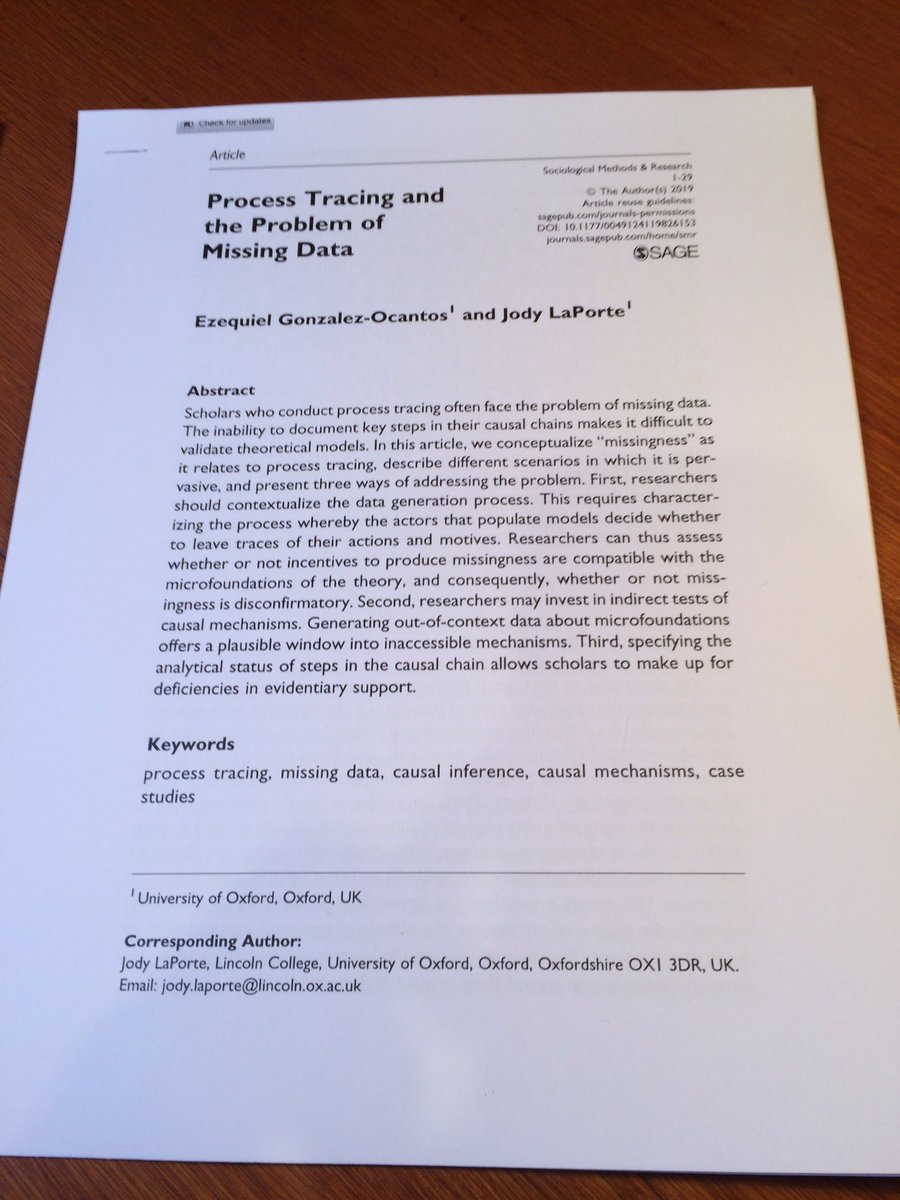
Les había prometido que si me daban medio "Like" les hacía un hilo para mi Twitter hispanoparlante sobre "cómo revisar un manuscrito al que le han dado R&R (revise-and-resubmit, o revisar-y-reenviar).
Tengo 45 minutos antes de irme a dormir, así es que, abro hilo.
Tengo 45 minutos antes de irme a dormir, así es que, abro hilo.
Algo que no estoy seguro que se enseñe en posgrados (al menos en Iberoamérica) es que el objetivo del envío es obtener, cuando menos, un R y R (revisar y reenviar).
Cuando yo era más joven, tuve mucha suerte que me aceptaron artículos arbitrados con cambios muy menores.
Cuando yo era más joven, tuve mucha suerte que me aceptaron artículos arbitrados con cambios muy menores.
Contra lo que se pudiera pensar, el tener éxito al principio de mi proceso de publicación (con aceptaciones directas y/o con cambios menores) minó mi capacidad de enfrentarme a las críticas, en ocasiones devastadoras, que me llegaron a hacer más adelante (en inglés Y en español)
Reitero, para mis estudiantes, mis asistentes de investigación, mis egresados, mis colegas:
El objetivo es el R&R.
Un R&R envía señales, tanto de parte del/de la editor(a) como de los dictaminadores: "creemos que se pueden hacer los cambios específicos para poder publicar".
El objetivo es el R&R.
Un R&R envía señales, tanto de parte del/de la editor(a) como de los dictaminadores: "creemos que se pueden hacer los cambios específicos para poder publicar".
Mi experiencia como Editor para las Américas del International Journal of Qualitative Methods, Editor Asociado del Journal of Environmental Studies and Sciences, Editor Asistente de Policy Design and Practice, me ha permitido ver un gran número de manuscritos en proceso.
En todos lados, obviamente, "se cuecen habas" y tanto en inglés como en español como en cualquier otro idioma y país nos vamos a encontrar dictaminadores terribles y editores que dejan pasar dichos dictámenes.
Por el momento, asumamos buena fé de todos en todo el proceso.
Por el momento, asumamos buena fé de todos en todo el proceso.
El recibir un R&R significa que el artículo no fue rechazado "al llegar al escritorio" (desk reject). En escala de malas noticias, lo peor es el rechazo en el escritorio, después el rechazo post-dictamen.
Pero recibir un R&R? Eso son buenas noticias!
Ahora, el proceso...
Pero recibir un R&R? Eso son buenas noticias!
Ahora, el proceso...
A mí, en lo personal, me estresan mucho los R&R.
Me siento feliz de que no me hayan rechazado, pero como cualquier persona, tengo sentimientos y en ocasiones me siento que no voy a poder con las críticas y recomendaciones.
Entonces, generalmente me doy 24 horas para leerlos.
Me siento feliz de que no me hayan rechazado, pero como cualquier persona, tengo sentimientos y en ocasiones me siento que no voy a poder con las críticas y recomendaciones.
Entonces, generalmente me doy 24 horas para leerlos.
Siempre que leo un dictamen de mis artículos, lo leo con la firme creencia de que la intención del dictaminador es ayudarme a mejorar el artículo (o capítulo cuando son libros dictaminados) y que el editor tiene interés de publicar mi artículo.
Entonces, los leo de buena fé.
Entonces, los leo de buena fé.
Una vez que leí todos los comentarios de ambos dictaminadores (o si son 3, de los 3), y del editor (o editora), preparo una tabla (la Matriz de Revisión de Borradores, Drafts Review Matrix, DRM) donde vacío los comentarios y sugerencias y críticas y mis respuestas/acciones. 

En mi blog tengo un formato de Drafts Review Matrix (DRM). raulpacheco.org/2018/02/an-imp…
Una vez que tengo mapeados todos los cambios que tengo que hacer, construyo un plan de ataque para poder realizarlos todos dentro del tiempo que me dan para reenviar el manuscrito.
Una vez que tengo mapeados todos los cambios que tengo que hacer, construyo un plan de ataque para poder realizarlos todos dentro del tiempo que me dan para reenviar el manuscrito.
Para ello uso una técnica denominada backcasting (también le pueden llamar ingeniería en reversa). Al aplicar backcasting a mi proyecto de revisión, hago un plan para trabajar en cada componente que tengo que terminar para reenviar el manuscrito revisado.
raulpacheco.org/2019/03/backca…
raulpacheco.org/2019/03/backca…
Conforme voy ejecutando cada componente de la revisión, voy agregando texto a la Carta de Respuesta a Editor y Dictaminadores (Response to Editor and Reviewers).
Mi guía está en este blog post:
raulpacheco.org/2020/08/writin…
Mi guía está en este blog post:
raulpacheco.org/2020/08/writin…
Obviamente, NADA garantiza que aún habiendo realizado los cambios, etc. se publique (el proceso es azaroso porque finalmente editores y dictaminadores son humanos y falibles). Pero con una buena carta de respuesta, y una revisión sistemática, se incrementan las posibilidades.
Algunos consejos derivados de mi experiencia como autor, dictaminador y editor de revista:
- Si no hacen un cambio, hay que justificar por qué (o las razones por las cuales están en desacuerdo con partes del dictamen).
- El tono cordial pero firme es posible :)
- Si no hacen un cambio, hay que justificar por qué (o las razones por las cuales están en desacuerdo con partes del dictamen).
- El tono cordial pero firme es posible :)
Muchas revistas solicitan un manuscrito "redlined" (marcado con tinta roja) que muestre los cambios que realizaron. Yo siempre sugiero hacer dos versiones: el "redlined" y el limpio (con todos los cambios aceptados) utilizando "track changes" de Word (u otra herramienta).
Lo más importante: creo firmemente que debemos dictaminar como nos gustaría que nos dictaminaran. Recomiendo muchísimo leer a fondo los materiales del Committee on Publishing Ethics (COPE) publicationethics.org
Espero que este hilo les sea de utilidad. Ahora sí, a dormir!
Espero que este hilo les sea de utilidad. Ahora sí, a dormir!
• • •
Missing some Tweet in this thread? You can try to
force a refresh












